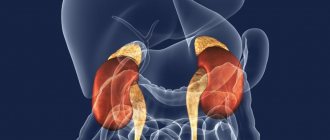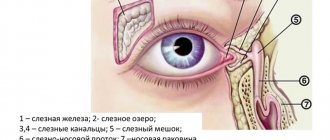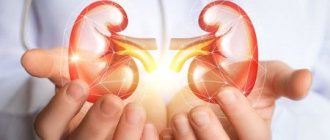The adrenal glands are a paired organ; on the right and left they are located above the kidneys and lie in the retroperitoneal tissue. The right adrenal gland is triangular in shape, located above the upper pole of the right kidney, directly adjacent to the inferior vena cava. The left adrenal gland has a semilunar shape, is located partially above the upper pole of the left kidney, and is in contact with the pancreas, spleen, and cardiac part of the stomach. The adrenal glands are supplied with blood by a large number of arteries. Venous blood flows through the central adrenal vein (on the right it flows directly into the inferior vena cava, on the left into the left renal vein).
Adrenal hormones
The adrenal medulla produces:
- Adrenaline is an important hormone in the fight against stress. The activation of this hormone and its production increases both with positive emotions and with stress and trauma. Under the influence of adrenaline, the pupils may enlarge and dilate, breathing becomes rapid, blood pressure increases, and a surge of strength is felt. Increases resistance to pain.
- Norepinephrine is a stress hormone that is considered a precursor to adrenaline. Has less impact on the body, participates in the regulation of blood pressure, which allows stimulating the work of the heart muscle
The adrenal cortex produces hormones of the corticosteroid class, which are divided into three layers: glomerular, fascicular, and zona reticularis. Hormones of the zona glomerulosa produce:
- Aldosterone is a hormone responsible for the exchange of potassium and sodium ions in human blood. Participates in water-salt metabolism, increases blood circulation, increases blood pressure
- Corticosterone is a low-active hormone that is involved in water-salt balance.
- Deoxycorticosterone is a hormone that increases resistance in the human body, gives strength to muscles and skeleton, and also regulates water-salt balance
Hormones of the zona fasciculata of the adrenal glands:
- Cortisol is a hormone that preserves the body's energy resources and is involved in carbohydrate metabolism. Cortisol levels often fluctuate, so in the morning it is much higher than in the evening
- Corticosterone – (see above) also produced by the zona fasciculata
Hormones of the reticular zone:
- Androgens are sex hormones that affect sexual characteristics: sexual desire, increased muscle mass and strength, body fat, lipid and cholesterol levels in the blood
Based on the above, adrenal hormones perform an important function in the human body; their excess or deficiency can lead to disruption throughout the body.
Diseases of the adrenal glands can be divided into pathology of form - tumors, cysts and function - aldosteroma, corticosteroma, pheochromocytoma, androsteroma, estroma. You can help diagnose diseases of the adrenal glands or identify disturbances in their functionality with the help of a series of examinations, which are prescribed by the doctor after collecting an anamnesis. To make a diagnosis, the doctor determines the adrenal hormones, which makes it possible to identify excess or deficiency of the latter. For adrenal tumors, the main screening diagnostic method is ultrasound, but a more accurate picture is provided by CT or MRI of the abdominal cavity and retroperitoneal space. The results of the examination make it possible to create a complete picture of the disease, determine the cause, identify certain disorders in the functioning of the adrenal glands and other organs and, accordingly, prescribe treatment, which can be carried out either by a conservative method or by surgical intervention.
When is a kidney ultrasound prescribed?
A kidney ultrasound may be prescribed if the following symptoms occur:
- pain in the lumbar region;
- urinary disorders;
- hematuria (blood in the urine).
Ultrasound of the kidneys in the clinics of JSC Family Doctor
Symptoms such as these may indicate kidney disease. Kidney ultrasound is one of the basic methods for diagnosing diseases such as:
- renal failure (kidney dysfunction);
- nephroptosis (pathological displacement, prolapse of the kidney);
- hydronephrosis (increasing expansion of the renal collecting system);
- pyelonephritis;
- glomerulonephritis;
- nephrolithiasis (kidney stones);
- kidney cyst;
- tumors.
If one of these diseases is suspected, the doctor usually prescribes an ultrasound of the kidneys. General practitioners (therapists), pediatricians, urologists and cardiologists can refer you for a kidney ultrasound.
Adrenal diseases:
Itsenko-Cushing syndrome is a pathological complex of symptoms that occurs as a result of increased secretion of the hormone cortisol by the tumor from the adrenal cortex. The production of cortisol and corticosterone is regulated by the pituitary gland through the production of adrenocorticotropic hormone. The activity of the pituitary gland is controlled by the hormones of the hypothalamus - statins and liberins. This multi-stage regulation is necessary to ensure the coherence of body functions and metabolic processes; disruption of one of the links can cause hypersecretion of adrenal hormones, which will lead to the development of Itsenko-Cushing syndrome. In contrast to Itsenko-Cushing's disease, the syndrome is manifested by a primary increase in hyperfunction of the adrenal cortex, while in Intsenko-Cushing's disease it is based on an ACTH-producing pituitary adenoma. In 20% of cases, the cause of Cushing's syndrome is a tumor of the adrenal cortex. The most characteristic sign of the syndrome is obesity of the Cushingoid type (fat deposits on the face, neck, chest, abdomen, back with relatively thin limbs), the face becomes red-purple in color, muscle atrophy, decreased muscle tone and strength are observed. Diagnostics: determination of cortisol excretion in daily urine, determination of cortisol in the blood, determination of ACTH in the blood, a small dexamethasone test is performed (normally, taking dexamethasone reduces the level of cortisol, with Itsenko-Kusching syndrome there is no decrease), a CT or MRI of the abdominal organs is performed. If there is a tumor in the adrenal gland, surgical treatment is performed. Symptomatic treatment for Itsenko-Cushing syndrome includes the use of antihypertensive, diuretic, hypoglycemic drugs, and cardiac glycosides. In case of Itsenko-Cushing's disease, surgical treatment of pituitary adenoma is performed.
Conn's syndrome (primary hyperaldosteronism, aldosteroma) is a symptom complex caused by greater production of aldosterone by the adrenal cortex. The cause is most often a tumor of the adrenal gland, less often - hyperplasia of the zona glomerulosa of the cortical layer. In patients, the amount of potassium decreases and the concentration of sodium in the blood increases, which causes blood pressure to increase.
The syndrome was first described by American scientist Conn in 1955, which is how it got its name.
Symptoms: weakness, fatigue, tachycardia, convulsions, headache, thirst, paresthesia of the limbs, increased blood pressure.
Conn's syndrome is accompanied by signs of damage to the heart and blood vessels, kidneys, and muscle tissue. Arterial hypertension can be malignant and resistant to antihypertensive therapy.
Diagnostics: study of blood electrolytes (high sodium, low potassium in the blood), an increase in the level of aldosterone in plasma, calculation of daily diuresis, determination of the level of renin in the blood, the ratio of plasma aldosterone and renin activity, determination of the level of aldosterone in daily urine, CT or MRI of the abdominal organs cavities - identification of tumors in the adrenal glands.
Therapeutic measures are aimed at correcting high blood pressure, metabolic disorders, as well as preventing possible complications caused by high blood pressure and decreased potassium in the blood. Conservative therapy is not radically capable of improving the condition of patients; complete recovery occurs only after surgical removal of the tumor.
Pheochromocytoma is a hormonally active tumor that actively secretes adrenaline and norepinephrine. Pheochromocytoma leads to the release of adrenaline or norepinephrine into the blood, which lead to the development of specific disorders in patients - a persistent crisis increase in blood pressure (sometimes more than 200/100 mmHg), not amenable to antihypertensive therapy, rapid heartbeat. Most often, pheochromocytoma is a tumor of the adrenal gland. Diagnosis is based on radiation and hormonal research methods. Radiation diagnostics: CT or MRI of the abdominal cavity and retroperitoneal space. Hormones: the level of chromogranin A, ACTH, aldosterone, renin, blood cortisol is determined, metanephrines, normetanephrines are determined in daily urine. Pheochromocytoma can be suspected by the presence of a formation in the adrenal gland, an increase in the level of metanephrines and normetanephrines in daily urine. The main treatment method for pheochromocytoma is adrenalectomy with tumor. Special attention is paid to preparation for surgery - the tasks of preoperative preparation of patients with pheochromocytoma are to normalize blood pressure levels, eliminate dangerous fluctuations during the day, and slow down the heart rate. The main drug used to prepare for surgery is doxazosin (Cardura). The drug is prescribed at least 2 weeks before the planned operation. The method of access for surgical treatment depends on the size of the tumor, location, hormonal activity
Estroma is a tumor of the adrenal cortex that produces large quantities of female sex hormones - estrogens. Typically these tumors are malignant. Estroms are very rare; clinically they manifest themselves in males as impotence, bilateral gynecomastia, feminization of the physique, and sometimes testicular hypotrophy. In most patients, along with feminization, there are signs of hypersecretion of gluco- and mineralocorticoids. Therefore, diagnosis consists of studying specific hormones in the blood and performing a CT or MRI of the abdominal organs. Surgical treatment is removal of the adrenal tumor.
Androsteroma is a hormonally active tumor of the adrenal gland that produces large quantities of male sex hormones. The picture of the disease in women is characterized by menstrual disorder (amenorrhea or oligomenorrhea), clitoral hypertrophy, facial and body hair growth, masculinization of the figure, deepening of the voice, and sometimes male pattern baldness. Some patients may experience hypertension and carbohydrate metabolism disorders in the form of hyperglycemia and a moderate increase in sugar in the urine. In men, androsteroma is extremely rare and does not show any external signs, so the diagnosis is made in a late stage of the disease. Diagnosis consists of performing a CT scan of the abdominal organs or MRI of the abdominal organs, the content of a high titer of androgens and their metabolites in daily urine. Treatment – removal of the adrenal tumor
Hormonally inactive adrenal tumor is a formation of the adrenal gland, most often benign in nature, not producing hormones in high quantities. These adrenal tumors can vary in size. Patients with hormonally inactive formations in the adrenal gland less than 3 cm are indicated for observation and dynamic testing of hormones. For tumors larger than 3 cm, or for tumor growth of more than 1 cm per year, surgical treatment is indicated. Diagnostics includes hormonal and biochemical blood and urine tests, CT or MRI of the abdominal organs.
Preparation for ultrasound of the kidneys and adrenal glands
Ultrasound of the kidneys and adrenal glands can be performed without preparation. However, if there is a large amount of gas in the intestine, the study may be uninformative.
Therefore, when undergoing a planned ultrasound of the kidneys and adrenal glands, it is recommended to abstain from foods that cause increased gas formation for three days before the study. First of all, you need to exclude legumes, raw vegetables, cabbage in any form, rye bread, milk, and carbonated drinks. The examination itself is best done on an empty stomach. It is recommended to limit yourself to a light dinner the day before, no later than 19:00.
Surgical treatment of adrenal diseases:
Currently, operations on the adrenal glands can be performed using traditional “open” access, or using high-tech methods (endoscopic operations). The standard access for adrenalectomy is most often lumbotomy or laparotomy - quite traumatic and time-consuming interventions. Such approaches as transdiaphragmatic, subdiaphragmatic, transthoracic can also be used. The Center for Endocrine Surgery widely uses endoscopic techniques in adrenal surgery, which can be either laparoscopic or extraperitoneal access. Endoscopic techniques are less traumatic compared to “open” surgery: in endoscopic operations there are 3 or 4 punctures of 1 cm each, patients spend less time in hospital treatment, recovery time is reduced by 2-3 times. The type of surgery is most often determined by the size of the tumor.
Symptoms
Symptoms of adrenal gland diseases appear gradually.
You may notice in yourself
- increased fatigue,
- muscle weakness,
- weight loss,
- nausea,
- low blood pressure.
Signs of dysfunction of the adrenal glands can also be: sleep disturbance, sexual weakness in men, changes in the cycle in women, tinnitus, osteoporosis, etc.
One of the signs of insufficient production of hormones by the adrenal glands is darkening in some areas of the skin (folds on the arms, elbows, around the nipples, etc.).








